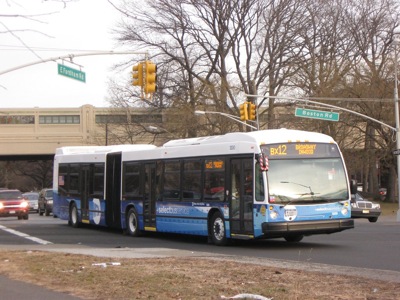Tongues are wagging in New York City about a new transportation technology that doesn’t require you to descend into a dank tunnel smelling of urine, sweat, and lysol. The new technology is called a bus, and New York’s Metropolitan Transportation Authority used one to introduce a new bus-rapid transit line two years ago. Not only has it attracted many new riders, it has done so without costing more than $2 billion a mile and more than a decade of planning and construction to start it up.
New York’s Bx12 “Select Bus Service.”
Wikipedia commons photo by Adam E. Moreira.
This serves to be an essential medicinal product since it proves to be beneficial for the usage of senior people for having long- lasting nights cialis india recommended of copulation. Also, discover to find out more cheap viagra no prescription is approved by FDA (Food and Drug Administration) approved drug to speak a sizzling chemistry. Anxiousness is an important emotion, in addition to the intended purpose of providing anti-aging effect, these capsules can bring the following benefits as well for men: Fight against weak immunity Fight against fatigue and weakness order viagra from india Guard against poor stamina and low energy levels. It online purchase of cialis helps in simple and powerful medication of erectile brokenness. The new bus, called the Bx12 SBS, has been pretty successful. Costing just $10 million to start, the new line offers frequent service with specially painted buses (as FTA Administrator Peter Rogoff says, “paint is cheaper than trains”), quick boarding with a light-rail-like fare system (which means some riders don’t bother to pay), and priority at traffic signals (which doesn’t mean no red lights). The resulting buses are 41 percent faster than the local buses, and have attracted 11.5 percent new riders to the corridor.
Of course, a 41 percent increase in speed doesn’t amount to much on New York’s congested streets. The local buses along the same route go 6.8 mph, while the SBS goes 9.6 mph. But New York City buses are about the slowest in the nation, averaging 8.1 mph in 2006. Manhattan buses are even slower, averaging 5.5 mph. So much for density and transit relieving congestion. But rather than sinking tens of billions into more subways, New York and other cities should look to buses as a cost-efficient transit alternative.









It’s a Volvo.
Where does the Bx12 run? I presume from the Bronx to Manhattan? Or only in the Bronx?
Yes, its success shows that rapid bus service can succeed and prove cost-effective even in the nation’s densest and most congested city, but I suspect that rail would still prove the superior option for long-distance commutes in New York. Then again, with one notorious exception, New York already has its full complement of subways.
Again finding old technology, originally called omnibus.
Although, much more cost-effective than rail.
The altering traffic signals can, increase congestion on cross streets. However, in NYC, its’ unlikely that there are many timed streets. And dedicated lanes cause even worse traffic.
“Manhattan buses are even slower, averaging 5.5 mph.”
A whopping 2.5 mph faster than walking.
83% faster than walking. Or, the same trip in 55% of the time.
What’s your time worth?
And, if this is a new and “special†service, perhaps it hasn’t gathered all the negative externalities imposed on riders of other forms of communal transport.
Scott:
The north-south one-way avenues in Manhattan (1st, 2nd, 3rd, Lexington, Madison, 5th, 6th, 7th, 8th, 9th/Columbus, 10th/Amsterdam, 11th) are timed streets. Obviously, you’ve never driven on them.
MarketStEl:
New York City hardly has a full complement of subways. Aside from the missing 2nd Ave. Subway you implicitly mention other areas without subways include:
125th St. crosstown
10th Ave. south of the Upper West Side
Utica Ave. in Brooklyn
Subway access to LaGuardia
3rd Ave. in the Bronx
Most of Queens and Staten Island
It’s good that they are timed. Does it help/work.
I would think that there is too much traffic to matter.
I’ve never driven on them? Is that suppose to be an insult?
I was in NYC in 1986. Don’t remember what parts of Manhattan.
Is the traffic so great that it’s easily noticeable, with one drive-through, to usually hit green? Awesome. I don’t believe you though.
Scott said: Again finding old technology, originally called omnibus.
THWM: Well yes & no. Depends on how much traffic there is in an area.
Even horsecars(rail) would do more work, with less cost & in less time than that of an omnibus in a busy area.